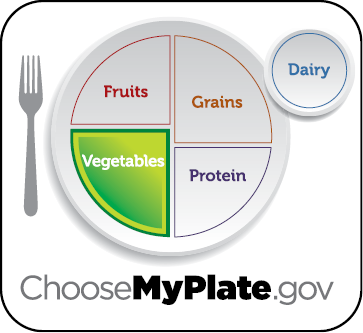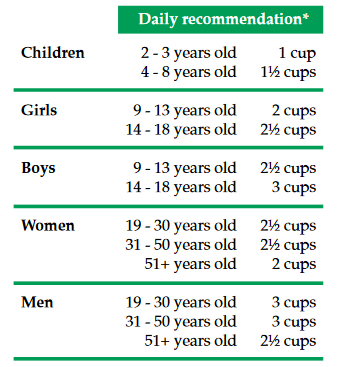Vary Your Veggies (FN727, Reviewed Aug. 2016)
Availability: Web only

The food icon, MyPlate, has many suggestions to help you meet the current recommendations for vegetables. “Servings” are in cups. For example, women ages 19 to 30 who get less than 30 minutes of physical activity per day should get 2½ cups of vegetables per day. Men of the same age should aim for 3 cups of vegetables per day.
Try these questions
1. True/false: Eating more vegetables may reduce your risk of stroke.
2. True/false: Eating more vegetables may lower your risk of type 2 diabetes.
3. True/false: Eating more vegetables may protect you from certain cancers.
All of the above are “true.” That’s an appealing thought, isn’t it?
Enjoy a variety of vegetables
Aim for vegetables of different colors because each different type provides its own nutrients and vitamins. Meals are more interesting with a variety of vegetables. Buy a different type of vegetable than your “usual” when shopping. Kids may enjoy picking out a new one to try, too.
Keep meals simple and economical
Try to buy fresh vegetables in season. They cost less and should be at peak flavor. Also, keep a supply of frozen and canned vegetables for easy microwave side dishes. Remember that most sodium comes from packaged and processed foods. To reduce sodium in your diet, buy canned vegetables labeled “no salt added” and drain regular canned products.
Pick easy-to-eat vegetables, such as baby carrots, grape tomatoes or bagged lettuce. These vegetables require little preparation. Vary your salads by changing the ingredients to fit your tastes and the season.
Make meals more appealing with vegetables
▲ Decorate plates with colorful vegetable slices.
▲ Add color to salads by adding carrots, red pepper or red cabbage.
▲ Enhance the color and flavor of chili, soup or stews with added vegetables.
▲ When grilling, add vegetable kabobs to your menu.
▲ Order veggie pizza and ask for extra veggies.
▲ Add vegetables to pasta sauces or lasagna.
▲ Try shredding carrots or zucchini into meatloaf, casseroles, quick breads and muffins.
Have regular vegetable snacks
▲ Keep cut-up vegetables such as celery sticks, baby carrots or red and green pepper slices in a see-through container in the refrigerator.
▲ Serve easy-to-eat vegetables to children after school or between meals.
▲ Set a good example by snacking on crunchy veggies, such as cauliflower and broccoli.
Keep vegetables safe
▲ Always wash vegetables before preparing or eating them. Wash under clean, running water and rub vegetables with your hands or a vegetable brush to remove dirt and surface microorganisms.
▲ Keep vegetables separate from raw meat, poultry and seafood while shopping, preparing and storing.
For additional information on vegetables
For more information about nutrition, food safety and health
Try this example
The amount of vegetables you need to eat depends on your age, sex and level of physical activity. Recommended total daily amounts are shown in the chart.
Question: How much vegetablesshould a 65-year-old man consume daily? __________

Answer: 2½ cups

